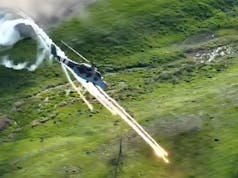A live trial led by Ministry of Defence scientists has showcased advanced robotic systems – including ‘robot dogs’ – successfully detecting and defusing bomb threats, according to a press release.
Conducted by the Defence Science and Technology Laboratory (Dstl) over four days, the trial tested:
- “Remote classification and identification of threats using sensors on robots,”
- “Defusing of bombs from a robot dog,”
- “Drones with AI autonomous threat and people detection,”
- and “robots conducting tasks such as opening doors and climbing stairs.”
This work is part of the government’s Plan for Change, with Dstl collaborating with British and international industry partners L3Harris, Marlborough Communications Ltd, and AeroVironment (Tomahawk Robotics). The press release highlights that the technology aims to reduce the need for bomb disposal operators to be placed in harm’s way, enhance the pace of operations through the use of AI-equipped drones, and improve overall public safety.
“This advanced technology demonstrates our commitment to protecting the military personnel who keep our nation safe, at home and abroad,” said Minister for Defence Procurement and Industry, Maria Eagle. “By working with industry and combining cutting-edge robotics with existing expertise, we’re ensuring our bomb disposal teams have the best possible tools to carry out their vital work safely and effectively. These advancements help the government deliver our Plan for Change and ensure defence is an engine for growth – protecting our national security while supporting rapidly evolving technologies.”
As part of the trial, robot systems were challenged to open and close doors autonomously, navigate stairs, inspect improvised explosive devices (IEDs), and fire disruptors at those IEDs to render them safe.
Bomb disposal operators provided feedback for the next phase of Dstl’s investment in robotic technology, ensuring continual refinement and improvement.
Chief Science and Technology Officer at Dstl, Professor Andy Bell, praised the collaborative effort:
“This is a great example of how Defence can achieve an advantage through the exploitation of technology, fusing together military and commercial systems to keep our people and country safe from deadly threats. Working in partnership with industry and academia, Dstl is delivering mission success through science and technology advantage.”
With the trial deemed a success, Dstl will use the insights gained to continue developing and enhancing the technology, aiming to reduce risk for those engaged in explosive ordnance disposal operations whilst maintaining public safety.
At the UK Defence Journal, we aim to deliver accurate and timely news on defence matters. We rely on the support of readers like you to maintain our independence and high-quality journalism. Please consider making a one-off donation to help us continue our work. Click here to donate. Thank you for your support!














Now we know why the MoD manages to spend $55billion each year and gets so little bang for the taxpayer’s buck
Nuclear weapons, and all that goes with that. Pensions. Ukraine money. AUKUS. GCAP.
Those are the main reasons.
Can they be distracted by throwing dog biscuits? Asking for a friend.